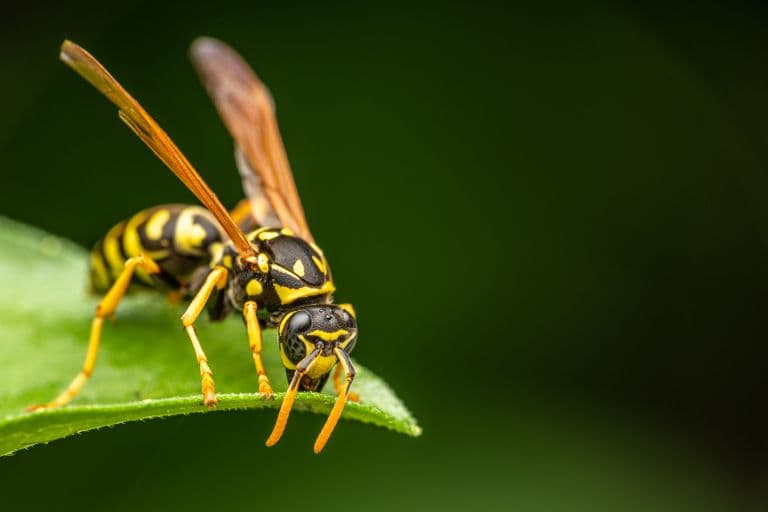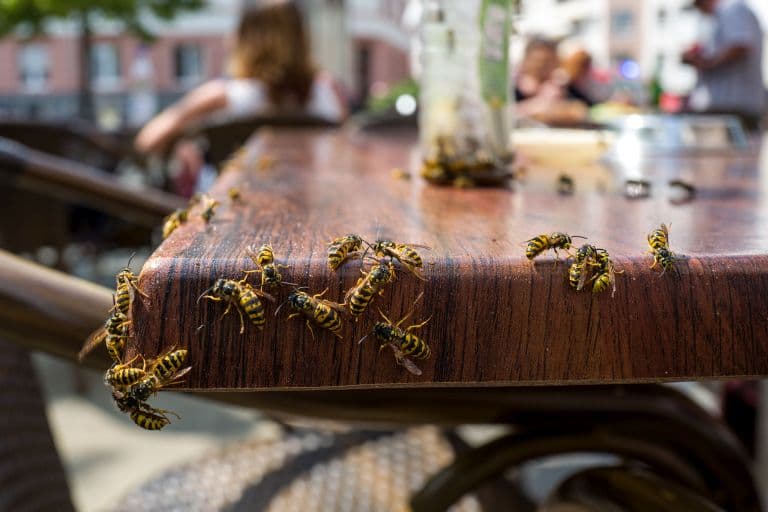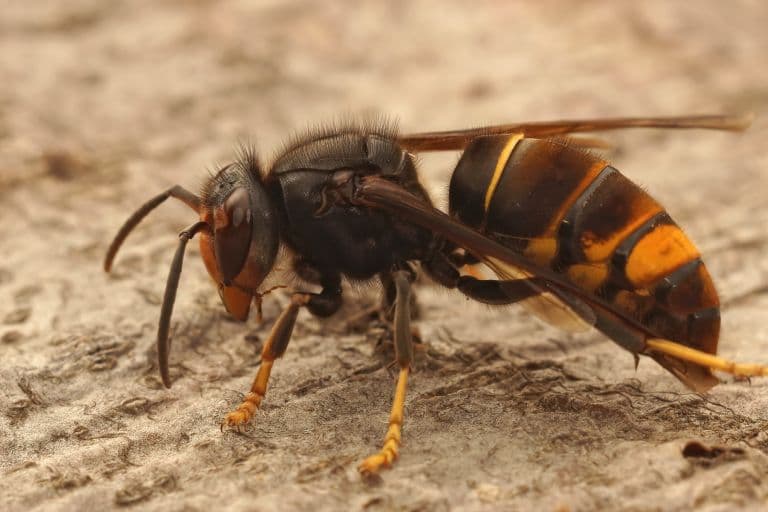Wasps get a truly bad rap. Over a hundred thousand species of pollinators, pest controllers, ecosystem engineers and keystone species were instantly condemned because of one time someone sat down in the grass without looking first.
And if wasps are scary, hornets are terrifying. Hornets are treated as wasps, bringing with them all the terror and irrationality that comes with suddenly facing the unprocessed trauma of that one bad picnic ten years ago.
But what makes hornets different? And how do you tell them from other wasps? More importantly, what’s all the fuss about?

Let’s find out the differences between a wasp and hornet.
1. Hornets are wasps
When most people think of wasps, they think of the yellowjackets that send them into a flapping frenzy when they come to inspect a coke can in the garden.
But wasps are so much more than the infamous striped stinger. There are well over 100,000 species of wasp. The vast majority of which are solitary, and the vast majority of which are parasitosis of other invertebrates.
So, the eusociality and predatory or nectar-feeding nature we associate with “wasps” actually only applies to a tiny minority.
But within this tiny minority, are the hornets. Hornets are a single genus of 22 species of eusocial wasps and one that gets all of the hate aimed at the sugar-feeding yellowjackets with a fraction of the justification. 1

2. Hornets are mostly tropical
The European hornet is the exception to this, and, for the pedants, so is the invasive Asian hornet that appears to be sweeping through North America. But the majority of the 22 species of hornet live in tropical countries.
Wasps, on the other hand, are everywhere. There’s likely one very close to you, right now.
3. Hornets are mostly bigger
The largest non-hornet wasp is the tarantula hawk moth. These solitary parasitoids are the size of a mouse and can be heard coming loudly into land in the savanna like the shot-through rotary engine of a Sopwith Pup.
Once terrestrial, they’ll scurry through the grass like a frenzied rodent looking for giant spider burrows.
Now, that’s a wasp.
And it dwarfs the largest hornet at around twice the size. Pepsis heros, the largest species of tarantula wasp, gets up to 11cm long, while the largest hornet, the Asian giant hornet, tops out at just over 2.5cm long.
But this is an exception! Most wasp species are significantly smaller, and especially in terms of mass. Even the large parasitoids are often gangly ichneumons and have nothing on the thick and chunky giant hornet.
Most wasps are nowhere near this large, and the majority of even paper wasps are far smaller than any hornet species. So, it’s safe to say that, in general, hornets are bigger than other wasps.

4. Hornet nests are bigger
This stands to reason, really. Hornets are the largest of the paper nest-building wasps, so you can spot their presence by looking at the structures they build, which you can see from a safer distance.
Hornet nests can be significantly larger than a soccer ball (one in Florida was said to be six meters across), and tear-drop shaped. Other wasps make a more spherical nest.
This rule gets complicated when dealing with other large genera like the “bald-faced hornet”, Dolichovespula maculate, which isn’t actually a hornet at all but just quite a big wasp.
So, you might have to look a bit closer. 2
5. Hornets can fly at night
Many of the parasitoid wasp species are nocturnal, but this is quite unusual for a wasp in the Vespinae subfamily.
Hornets seem to be able to navigate by night without any special adaptations and can do so as they choose. While mostly diurnal, these impressive wasps are proving more adaptable than their purely diurnal peers, even though their eyes are not as good at seeing in the dark.
What they get up to at night remains a spooky mystery. 3
6. Hornets don’t care for plants
We all know bees as the helpful little pollinators who give us honey and fertilise our food, but wasps are truly unsung heroes in this regard.
Most species of hunting wasps are merely looking for spider fruit for their voracious larvae; they themselves are predominantly nectar-feeders. And many wasps pollinate plants that bees don’t feed on, making them of critical importance!
But not hornets. Like several eusocial wasp species, hornets are bloodthirsty hunters and wouldn’t touch a vegetable even if it was dipped in the blood of their enemies.
As such, hornets are not pollinators, but this doesn’t mean they’re of no economic value to our food industries; like other hunting wasps, they are excellent pest control.
This has other implications, as well. The common fear for wasps comes from the often overlapping lifestyles between humans and paper wasps, like the Vespula genus, who will readily try to share your sugary drink on a Summer’s day and fight you when you try to accidentally swallow them.
These animals are opportunistic scavengers and will be drawn to sweet-smelling human food. But hornets, as predators, aren’t about all that, so they are less likely to come into contact with people anyway. And if they do, they’re generally pushovers. 4

7. Hornets aren’t particularly aggressive
Despite being potentially dangerous, hornets, like most wasps, are rarely aggressive. Some species of smaller wasps have a far faster trigger than most hornet species, and as mentioned, a European hornet who isn’t defending her nest is a piece of cake to work with.
They can even be handled without much risk and can be removed from a bedroom window without the need for the cup and postcard trick. And if you do manage to get good at this, it’s a great way to terrify the neighbours. 5
8. But hornets can kill people
No animal attacks for no reason. You may not agree with, or even understand the reason, but animals – and life as a rule – are all about conserving valuable energy, so attacking stuff for the fun of it is in direct contrast with the primary directive.
In almost every case, a sting from most species is an annoyance, rather than an emergency (people with allergies are politely excluded). That said, there are some exceptions, and the Asian giant hornet is a good one.
While the European hornet is as docile as an opiated manatee, the big Asian ladies of the genus aren’t so placid. Still, they’ll only attack when threatened; the trouble is, you don’t always know you’re threatening them. And when they sting, it can be dangerous.
This species is responsible for up to 50 deaths a year in Japan alone. They have an incredibly potent venom and the heightened aggression results in mob mentality and more stings than most other species of wasp would bring you.
Having said that, it’s likely that honeybees – you know, those cute hymenopterans nobody has a problem with – kill more people worldwide than hornets and wasps combined. So, keep that in mind next time you’re killing things out of fear!
Final Thoughts
So there you have it – wasps versus hornets!
Hornets and wasps aren’t so different – in fact, in the case of hornets, they’re the same thing.
Wasps are a spectacularly diverse and woefully disrespected branch of stinging insects that are not only awesome but also some of the most important animals in the ecosystem.
Hornets make up a small genus of 22 wasps, known for their large size and consequent ability to scare the crap out of sheltered humans.
But they’re not all that scary, and while there are some exceptions, such as allergies and one particularly dodgy Asian species, hornets are, on the whole, no more dangerous than honeybees.
Fact Sources & References
- https://www.sciencedirect.com/topics/agricultural-and-biological-sciences/vespa
- https://edition.cnn.com/videos/bestoftv/2013/06/11/dnt-giant-hornet-nest.wctv
- https://www.ncbi.nlm.nih.gov/pmc/articles/PMC3134451/
- https://phys.org/news/2019-11-wasps-effective-pest-agriculture.html
- https://agr.wa.gov/departments/insects-pests-and-weeds/insects/hornets/human-health
